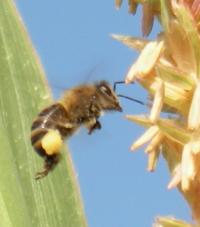ENV Risk Mitigation Pollinators › Risks to Insect Pollinators
Risks to Insect Pollinators
- Risk to Insect Pollinators
- Decline in Insect Pollinators
- Managing Pesticide Risk to Insect Pollinators
| Risk to Insect Pollinators |
|
The abundant availability of many fruits and vegetables is due in large part to the pollination services that bees and other insect pollinators provide. The Food and Agriculture Organisation of the United Nations (FAO) estimates that out of some 100 crop species which provide 90% of food worldwide, 71 of these are bee-pollinated. In Europe alone, 84% of the 264 crop species are animal pollinated and 4 000 vegetable varieties exist thanks to pollination by bees. The production value of one tonne of pollinator-dependent crop is approximately five times higher than one of those crop categories that do not depend on insects (UNEP, 2010; UNEP Emerging Issues: Global Honey Bee Colony Disorder and Other Threats to Insect Pollinators, United Nations Environment Programme, Nairobi, page 1). In addition to being a critical input to commercial agriculture through pollination services, bees also contribute to the market directly through production of goods such as honey, wax and propolis. While managed bees are an important component of commercial agriculture and contribute to the market place, perhaps more importantly is the contribution bees (particularly non-managed) and other insect pollinators (e.g. butterflies, beetles, etc.) make to biodiversity and the health and balance of ecosystems.
|
Photo credit:J. Pistorius |
| Decline in Insect Pollinators |
|
In recent years, worldwide declines in managed and non-managed pollinators have led to an increased global dialogue and focus on the potential factors that may be causing these declines. Due to its importance in crop production and our ability to survey and track its status, the honey bee (Apis mellifera), has been at the centre of global concerns of pollinator declines. Although a number of factors have been hypothesized as potential contributors to pollinator declines, at this time, no single factor has been identified as the cause. The potential factors suggested to contribute to global declines include:
Research around the globe is being directed at identifying the individual and combined stressors that are most strongly associated with pollinator declines. While there is uncertainty regarding the extent to which pesticides contribute to the decline in pollinator health, the existing knowledge on the effects of pesticides on bees, as well as bee-loss incidents associated with pesticide exposure have highlighted the need for regulatory agencies to advance their ability to assess the potential risk that pesticides pose to insect pollinators and to improve their tools to mitigate risks to insect pollinators.
|
Photo credit:J. Pistorius |
| Managing Pesticide Risk to Insect Pollinators |
| Regulatory authorities must balance the benefit of pesticides, and their contribution to meeting the increasing demand for safe and abundant food and fiber, with the potential risks that they may pose. If the risks from a pesticide become inconsistent with the goals of a regulatory agency (e.g., to protect human health and the environment), then regulatory authorities may explore options to mitigate the risk in order to bring the risks of that pesticide into balance with its benefits and into concert with the protection goals of the regulatory agency and societies they serve.
|
Related Documents


